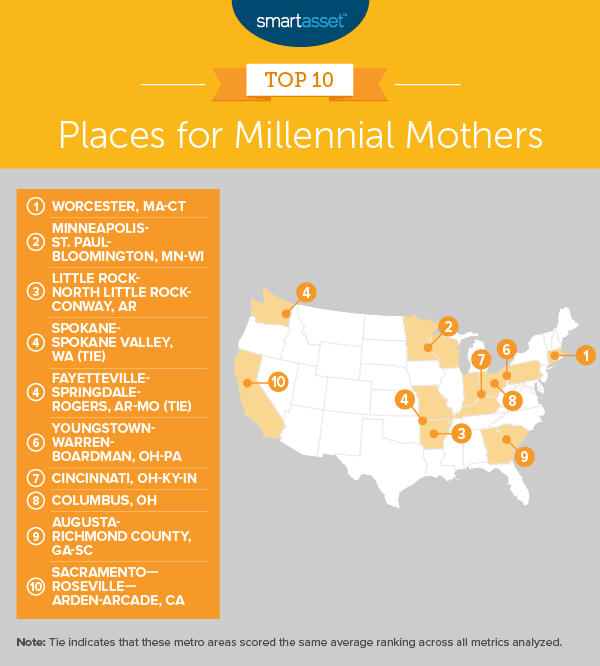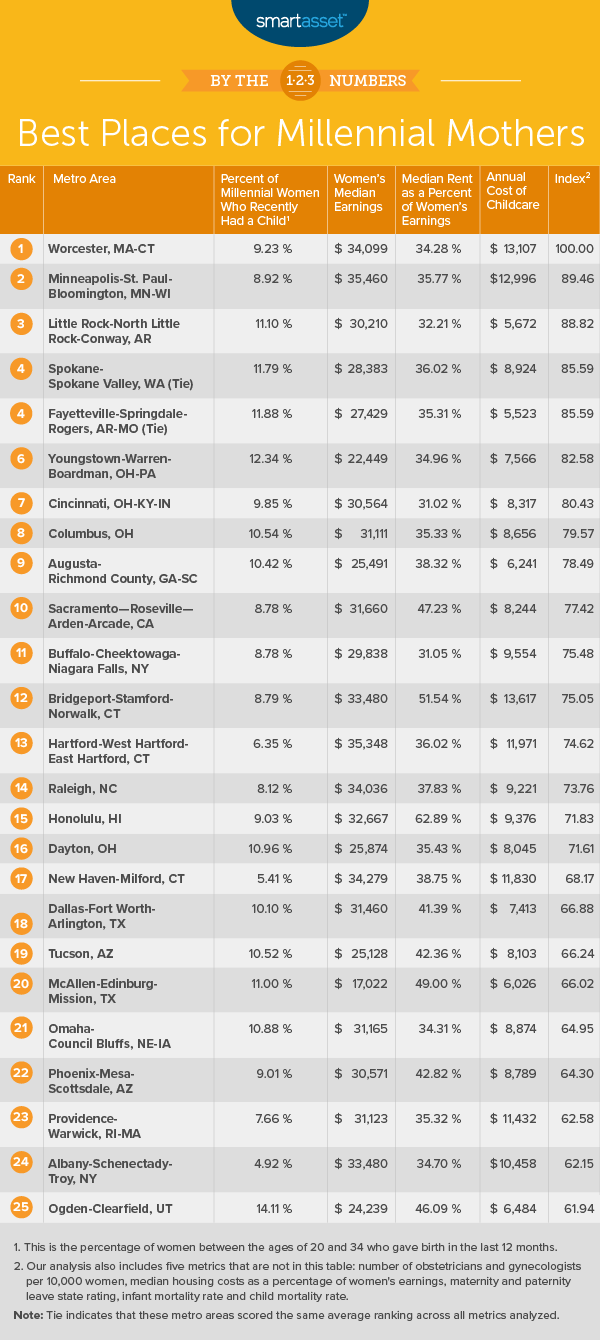
According to the National Center for Health Statistics, about 3.9 million births were registered in the U.S. in 2017, with millennial women accounting 80% of them. The average age of mothers at first birth was 26.8, and especially for those millennial mothers at the start of their careers, where they choose to start a family can have a substantial influence on their ability to have a safe pregnancy and birth while also building their savings afterward.
In this study, we take a closer look at some of the best places specifically for millennial women who are looking to become or who have recently become mothers. In order to determine some of the best places for millennial mothers, we looked at data for 100 metro areas across nine metrics. These nine metrics encompass a variety of factors specific to women and parents such as average earnings for women, the concentration of obstetricians and gynecologists and average annual cost of childcare, along with more general affordability factors. For details on our data sources and how we put the information together to create our final rankings, check out the Data and Methodology section below.
Key Findings
- There are great places for millennial mothers in all regions. The Northeast, Midwest, South and West are all represented in our top 10.
- Childcare and housing add up. The average annual cost of childcare across all 100 metro areas is a little less than $9,000 a year, while median rent or median housing costs are about $12,000 a year in many places. This means that most millennial parents will spend more than $20,000 a year on the two expenses, often more than 50% of a single parent’s annual income. In fact, the highest median annual earnings for women of any metro area in our study is $42,296.
1. Worcester, MA-CT
Worcester, Massachusetts-Connecticut ranks in the top half of all metro areas for eight of the nine metrics we considered. Median annual earnings for women are the 13th-highest of all metro areas included in our study, and as a state, Massachusetts has the highest maternity and paternity leave rating from the National Partnership for Women and Families.
Worcester may be a better location for millennial mothers looking to continue to rent rather than buy a house. According to Census estimates, in 2017, rent as a percentage of women’s earnings was 34.28%, the 15th-lowest of any metro area in our study, while housing costs as a percentage of women’s earnings was 42.72%, ranking toward the middle of all metro areas.
2. Minneapolis-St. Paul-Bloomington, MN-WI
Minneapolis-St. Paul-Bloomington, Minnesota-Wisconsin has the eighth-highest annual earnings for women of any metro area, $35,460, and the highest of any place in our top 10. Additionally, Minnesota has a higher number of obstetricians and gynecologists relative to the population of women. The Bureau of Labor Statistics (BLS) reports that there were 580 obstetricians and gynecologists in the state in 2017. With about 2.8 million women in the state, there are about 2.07 obstetricians and gynecologists per 10,000 women.
Minneapolis-St. Paul-Bloomington is one of the metro areas that ranks poorly for childcare affordability. The Economic Policy Institute’s Family Budget Calculator estimates that the annual cost of childcare for a single child in Minneapolis-St. Paul-Bloomington is $12,996, the seventh-highest amount of any metro area in our study.
3. Little Rock-North Little Rock-Conway, AR
Little Rock-North Little Rock-Conway, Arkansas is a very affordable place for millennial mothers. Across all metro areas, it ranks fifth and first on our two housing affordability measures, annual rent as a percentage of women’s earnings and annual housing costs as a percentage of women’s earnings, respectively. Specifically, in 2017, annual rent as a percentage of women’s earnings was 32.21% and annual housing costs as a percentage of women’s earnings was comparable at 33.17%.
Even though the Little Rock metro area excels at the economic and affordability metrics above, it lags compared to other metro areas in our top 10 on several health-related measures. As a state, Arkansas only has 0.85 obstetricians and gynecologists per 10,000 women, much lower than Massachusetts and Minnesota which have 1.50 and 2.07, respectively. Child and infant mortality rates in Little Rock-North Little Rock-Conway are also relatively high. According to 2019 data from countyhealthrankings.org, there were 71.76 deaths among children under the age of 18 per 1,000 live births and 8.26 deaths among children under the age of one per 1,000 live births, the 14th– and 17th– highest of any metro area in our study.
4. Spokane-Spokane Valley, WA (Tie)
Located in eastern Washington and close to the border the state shares with Idaho, Spokane-Spokane Valley ties for fourth place in our study. The metro area ranks in the top half of the study for six of the nine metrics we considered. Specifically, child and infant mortality rates in Spokane County are low, and Washington State ties for the third-highest maternity and paternity leave rating, according to the National Partnership for Women and Families’ report on working family caregivers.
4. Fayetteville-Springdale-Rogers, AR-MO (Tie)
Fayetteville-Springdale-Rogers, Arkansas-Missouri ties with Spokane-Spokane Valley for fourth. Like Little Rock-North Little Rock-Conway, the other metro area located in Arkansas in our top 10, Fayetteville-Springdale-Rogers has generally low childcare costs. The Economic Policy Institute’s Family Budget Calculator estimates that childcare in Fayetteville-Springdale-Rogers costs about $5,500, even lower than Little Rock-North Little Rock-Conway and the third-lowest amount for this metric across all 100 metro areas that we considered.
6. Youngstown-Warren-Boardman, OH-PA
The percentage of women between 20 and 34 who gave birth in the last 12 months is the highest in Youngstown-Warren-Boardman, Ohio-Pennsylvania of any metro area in our top 10. According to Census estimates, in 2017, 12.34% of women between the ages of 20 and 34 gave birth in the last 12 months. This is important for millennial mothers looking for a sense of community within the place they live.
Unfortunately, working millennial mothers may make less in this metro area than in other places in our top 10. According to Census estimates, in 2017, median annual earnings for women in this metro area were $22,449, the lowest of any metro area in our top 10 and the fifth-lowest overall. But rent and housing costs represent a relatively low percent of women’s earnings in this region.
7. Cincinnati, OH-KY-IN
Cincinnati, Ohio-Kentucky-Indiana is an affordable spot for new parents. In 2017, annual rent as a percentage of women’s earnings was 31.02% and annual housing costs as a percentage of women’s earnings was 36.87%, the lowest and 14th-lowest rates of any metro area, respectively.
Child and infant mortality rates in Hamilton County, in which Cincinnati is located, are high. Data from countyhealthrankings.org shows that there were 74.28 deaths among children under the age of 18 per 1,000 live births and 9.32 deaths among children under the age of one per 1,000 live births, the 10th and 7th highest of any metro area in our study.
8. Columbus, OH
Following Cincinnati and ranking eighth overall, Columbus, Ohio is a popular place for millennial mothers, with many millennial mothers already living in Columbus. According to Census estimates, in 2017, 10.54% of women between the ages of 20 and 34 gave birth in the last 12 months, the fifth-highest of any metro area in our top 10 and 19th-highest overall.
9. Augusta-Richmond County, GA-SC
Augusta-Richmond County, Georgia-South Carolina has the eighth-lowest annual cost of childcare of any metro area in our study, at $6,241. It ranks in the top half of our study for child and infant mortality rates. It also ranks in the more affordable half of our study for both rent as a percentage of women’s earnings and annual housing costs as a percentage of women’s earnings. According to Census estimates, in 2017, 10.42% of women between the ages of 20 and 34 gave birth in the last 12 months, a top-25 rate overall.
10. Sacramento-Roseville-Arden-Arcade, CA
Median earnings for women in Sacramento, California metro area – our No. 10 best place for millennial mothers – are relatively high. The Census reported that in 2017, median annual earnings for women in the Sacramento metro area were $31,660, a top-25 rate. Additionally, California has the sixth-highest maternity and paternity leave score out of all 50 states and Washington, D.C. The Sacramento metro area also ranks within the top 25 of the study for low child and infant mortality rates.
Data and Methodology
To find the best places for millennial mothers, SmartAsset analyzed data on 100 metro areas. Specifically, we compared metro areas across the following nine metrics:
- Percentage of new millennial mothers. This is the percentage of women between the ages of 20 and 34 who gave birth within the past 12 months. Data comes from the U.S. Census Bureau’s 2017 1-year American Community Survey.
- Median earnings for women. Data comes from the U.S. Census Bureau’s 2017 1-year American Community Survey.
- Obstetricians and gynecologists per 10,000 women. This is the number of obstetricians and gynecologists in a state per 10,000 women in the state. Data on the number of obstetricians and gynecologists comes from the Bureau of Labor Statistics and is for 2017. Data on the number of women in the state comes from U.S. Census Bureau’s 1-year American Community Survey and is for 2017.
- Annual cost of childcare. This is the annual cost of childcare for a single child in each metro area. Data comes from the Economic Policy Institute’s Family Budget Calculator and is for 2017.
- Rent as a percentage of women’s earnings. This is median annual rent as a percentage of median women’s earnings. Data on both metrics comes from the U.S. Census Bureau’s 2017 1-year American Community Survey.
- Housing costs as a percentage of women’s earnings. This is the median annual housing cost for homeowners as a percentage of median women’s earnings. Data on both metrics comes from the U.S. Census Bureau’s 2017 1-year American Community Survey.
- Maternity and paternity leave state rating. This is a state by state ranking that reflects the degree to which each state improves upon federal law concerning paid or unpaid workplace leave. Data comes from the National Partnership for Women and Families’ report on working family caregivers and is for 2018.
- Child mortality rate. This is the number of deaths among children under 18 years old per 1,000 live births. Data is from countyhealthrankings.org for 2019.
- Infant mortality rate. This is the number of deaths among children under one year old per 1,000 live births. Data is from countyhealthrankings.org for 2019.
First, we ranked each metro area in every metric. We gave half a weight to the two housing-related metrics, annual rent as a percentage of women’s earnings and annual housing costs as a percentage of women’s earnings, and the two mortality rates, infant mortality rate and child mortality rate. All other factors were given a full weight. We then found each area’s average ranking and used the average to determine a final score. The metro area with the best average ranking received a score of 100. The metro area with the lowest average ranking received a score of 0.
Tips for Finding a Home
- Make sure you can handle a mortgage. As you get set to nest and create a home for the new addition to your family, recognize that a mortgage is a big commitment. Be certain you’ll be able to afford whatever you’ll end up having to pay. Use SmartAsset’s mortgage calculator to see the ideal range in which you should be shopping.
- Trusted personal finance advice. A financial advisor can help you make smarter financial decisions such as moving or being in better control of your money after you land a new job. Finding the right financial advisor that fits your needs doesn’t have to be hard. SmartAsset’s free tool matches you with financial advisors in your area in 5 minutes. If you’re ready to be matched with local advisors that will help you achieve your financial goals, get started now.
Questions about our study? Contact us at press@smartasset.com
Photo credit: ©iStock.com/jacoblund

